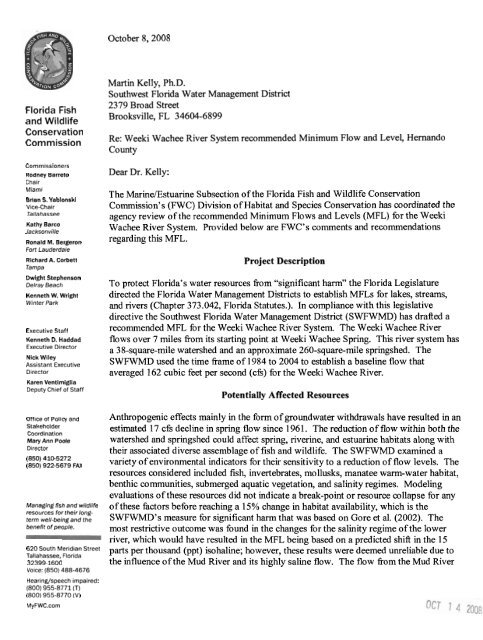Weeki Wachee River System Recommended Minimum Flows and ...
Weeki Wachee River System Recommended Minimum Flows and ...
Weeki Wachee River System Recommended Minimum Flows and ...
You also want an ePaper? Increase the reach of your titles
YUMPU automatically turns print PDFs into web optimized ePapers that Google loves.
October 8,2008<br />
Florida Fish<br />
<strong>and</strong> Wildlife<br />
Conservation<br />
Commission<br />
Commissioners<br />
Rodney Barreto<br />
Chair<br />
Miami<br />
Brian S. Yablonski<br />
Vice-Chair<br />
Tallahassee<br />
Kathy Barco<br />
lacksonville<br />
Ronald M. Bergeron<br />
Fort Lauderdale<br />
Richard A. Corbett<br />
Tampa<br />
Dwight Stephenson<br />
Delray Beach<br />
Kenneth W. Wright<br />
Winter Park<br />
Executive Staff<br />
Kenneth D. Haddad<br />
Executive Director<br />
Nick Wiley<br />
Assistant Executive<br />
Director<br />
Karen Ventimiglia<br />
Deputy Chief of Staff<br />
Office of Policy <strong>and</strong><br />
Stakeholder<br />
Coordination<br />
Mary Ann Poole<br />
Director<br />
(850) 41S5272<br />
(850) 922-5679 FAX<br />
Managing fish <strong>and</strong> wildlife<br />
resources for their longterm<br />
well-being <strong>and</strong> the<br />
benefit of people.<br />
620 South Meridian Street<br />
Tallahassee. Florida<br />
32399-1600<br />
Voice: (850) 488-4676<br />
Hearinuspeech impaired:<br />
(800) 955-8771 (T)<br />
(800) 955-8770 (V)<br />
MyFWC.com<br />
Martin Kelly, Ph.D.<br />
Southwest Florida Water Management District<br />
2379 Broad Street<br />
Brooksville, FL 34604-6899<br />
Re: <strong>Weeki</strong> <strong>Wachee</strong> <strong>River</strong> <strong>System</strong> recommended <strong>Minimum</strong> Flow <strong>and</strong> Level, Hern<strong>and</strong>o<br />
County<br />
Dear Dr. Kelly:<br />
The MarineIEstuarine Subsection of the Florida Fish <strong>and</strong> Wildlife Conservation<br />
Commission's (FWC) Division of Habitat <strong>and</strong> Species Conservation has coordinated the<br />
agency review of the recornrnended <strong>Minimum</strong> <strong>Flows</strong> <strong>and</strong> Levels (MFL) for the <strong>Weeki</strong><br />
<strong>Wachee</strong> <strong>River</strong> <strong>System</strong>. Provided below are FWC's comments <strong>and</strong> recommendations<br />
regarding this MFL.<br />
Project Description<br />
To protect Florida's water resources fiom "significant harm" the Florida Legislature<br />
directed the Florida Water Management Districts to establish MFLs for lakes, streams,<br />
<strong>and</strong> rivers (Chapter 373.042, Florida Statutes.). In compliance with this legislative<br />
directive the Southwest Florida Water Management District (SWFWMD) has drafted a<br />
recornrnended MFL for the <strong>Weeki</strong> <strong>Wachee</strong> <strong>River</strong> <strong>System</strong>. The <strong>Weeki</strong> <strong>Wachee</strong> <strong>River</strong><br />
flows over 7 miles fiom its starting point at <strong>Weeki</strong> <strong>Wachee</strong> Spring. This river system has<br />
a 38-square-mile watershed <strong>and</strong> an approximate 260-square-mile springshed. The<br />
SWFWMD used the time frame of 1984 to 2004 to establish a baseline flow that<br />
averaged 162 cubic feet per second (cfs) for the <strong>Weeki</strong> <strong>Wachee</strong> <strong>River</strong>.<br />
Potentially Affected Resources<br />
Anthropogenic effects mainly in the form of groundwater withdrawals have resulted in an<br />
estimated 17 cfs decline in spring flow since 1961. The reduction of flow within both the<br />
watershed <strong>and</strong> springshed could affect spring, riverine, <strong>and</strong> estuarine habitats along with<br />
their associated diverse assemblage of fish <strong>and</strong> wildlife. The SWFWMD examined a<br />
variety of environmental indicators for their sensitivity to a reduction of flow levels. The<br />
resources considered included fish, invertebrates, mollusks, manatee warm-water habitat,<br />
benthic communities, submerged aquatic vegetation, <strong>and</strong> salinity regimes. Modeling<br />
evaluations of these resources did not indicate a break-point or resource collapse for any<br />
of these factors before reaching a 15% change in habitat availability, which is the<br />
SWFWMD's measure for significant harm that was based on Gore et al. (2002). The<br />
most restrictive outcome was found in the changes for the salinity regime of the lower<br />
river, which would have resulted in the MFL being based on a predicted shift in the 15<br />
parts per thous<strong>and</strong> (ppt) isohaline; however, these results were deemed unreliable due to<br />
the influence of the Mud <strong>River</strong> <strong>and</strong> its highly saline flow. The flow from the Mud <strong>River</strong>
















